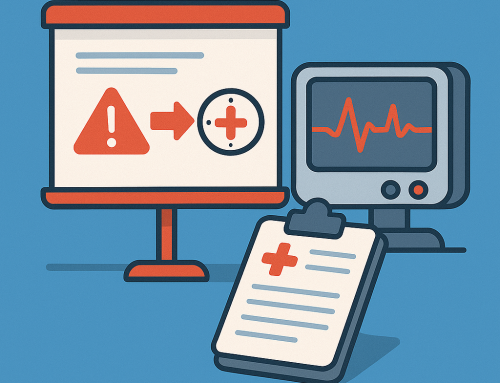In times of crisis, seconds matter. Emergency rooms (ERs), more than nearly anyone else, prove this, as every decision could be a choice between life and death. Far from replacing clinicians, AI in ERs transforms these high-stress, high-pressure environments into manageable hubs of precision, speed, and efficiency.
With the emergence of AI, it’s becoming even easier to make smarter decisions faster. Doctors now have access to groundbreaking tools that enable faster diagnoses, smarter workflows, and more personalized patient care.
It’s obvious that AI is already used in emergency rooms. But the question is, are you keeping up with AI healthcare trends? Are you effectively leveraging AI’s potential, or are there new opportunities to explore?

How Doctors Are Using AI in Emergency Rooms
AI is reshaping emergency care by providing tools that assist clinicians in processing data and optimizing workflows.
Today, AI in emergency settings primarily focuses on the following key areas:
1. Rapid Diagnoses
Conditions such as strokes, sepsis, and heart attacks require quick diagnoses. Current AI systems can analyze patient data, such as CT scans or lab results, in real time. AI supports clinicians by identifying the most efficient combination of diagnostic tests or predicting admission rates, helping teams allocate resources effectively. This ensures better care while minimizing waste.
2. Triage Automation
Healthcare professionals’ manual workload makes it difficult to prioritize patient care accurately. However, AI-based triage tools can now assess patients’ vital signs and medical histories to give them the care they need when they need it.
For example, during a mass casualty event, AI can quickly process data from multiple patients and provide medical teams with insights to guide urgent interventions.
3. Personalized Treatment Plans
Modern emergency care increasingly demands personalized approaches, which are often time-consuming. AI helps by predicting outcomes and suggesting tailored treatment plans based on patient medical history, current conditions, and genetic markers. These data-driven insights enable doctors to offer more individualized care without adding to their workload.
4. Resource Optimization
ERs operate under tight budgets and high patient volumes with a limited number of resources. AI aids with that limitation by supporting clinicians in identifying the most efficient combination of diagnostic tests or predicting admission rates. Whether it’s determining the most cost-effective diagnostic test or predicting patient admission rates, these systems optimize workflow while minimizing waste.
Comparing AI Use in Your Emergency Room
Integrating AI into emergency medicine requires a balanced approach. AI technologies make medical practices more manageable and keep the focus on empowering healthcare professionals.
Conduct a Workflow Audit
Examine each phase of your current ER workflow to identify opportunities where AI can assist, such as in triage or discharge planning. Use AI tools rather than relying solely on them for diagnostics. The goal is to enhance every aspect of the patient care experience with tools that improve clinical expertise.
Measure ROI
AI should mean measurable improvements. Compare key metrics—such as wait times, patient outcomes, and operational costs—before and after AI implementation. When leveraged correctly, AI often translates to greater ER efficiency in these areas while easing the workload on the medical staff.
Stay Updated on Trends
Engage with hospitals that are early adopters of cutting-edge AI tools. Learning from their successes, and especially their challenges, can inspire you to implement similar advancements. A collaborative approach keeps the focus on supporting clinicians and ensuring patient care excellence. Some emergency rooms have even found that new AI tools in natural language processing (NLP) or robotics complement their current solutions.
Key Trends in AI for Emergency Rooms
AI is constantly evolving, and analyzing trends helps emergency rooms become more competitive. Here’s what’s shaping the future of AI in emergency rooms.
1. Natural Language Processing for Documentation
ERs generate massive amounts of data, including everything from patient records to clinical notes. To solve the massive increase in data, AI-based NLP systems are now automating documentation, converting voice or written inputs into comprehensive medical records. By taking over administrative tasks, clinicians can spend more time focusing on their patients.
2. Wearable AI Technology
Wearable technology with AI capabilities is transforming patient monitoring. These devices transmit data like vital signs and early warning alerts, helping ER teams prepare for incoming cases. In many situations, AI-enabled wearables can identify irregular heart rhythms at home and notify the ER for immediate readiness.
3. Robotic-Assisted Care
AI-powered robotics are making their way into trauma settings, performing precise interventions such as IV insertions or assisting in lifesaving surgeries. These robots are guided by algorithms to enhance the precision of procedures while working in tandem with the professional clinicians who remain at the helm.
4. Ethical AI Implementation
AI isn’t perfect, and ethical concerns are creating incentives for developing bias-free algorithms in healthcare. Future systems will prioritize equitable care, ensuring that treatment recommendations aren’t influenced by subconscious biases present in historical healthcare data. These efforts aim to establish AI as a trusted partner to medical professionals. It’s a technology in its infancy, but it’s an invaluable step in the right direction.
Benefits of AI in Emergency Rooms
AI offers clear advantages, but the emphasis remains on its role as a supportive tool for the clinicians who drive patient outcomes.
- Improved Patient Outcomes: Faster diagnoses and personalized care reduce complications and mortality rates.
- Operational Efficiency: AI streamlines workflows, triages patients faster, and helps staff focus on high-priority tasks.
- Cost Savings: Optimizing resources with AI leads to a significant reduction in unnecessary testing or procedures.
- Enhanced Doctor-Patient Interaction: By automating administrative duties, AI gives doctors more time to connect with patients.
- Scalability: AI solutions adapt to growing patient volumes, ensuring exceptional care even during peak times.
Incorporating AI in Your Emergency Room
AI is transforming emergency medicine, but it remains most valuable as a complementary accessory to clinicians’ skills and expertise. Ensure proper training and infrastructure to maximize these tools’ potential while keeping the focus on enhancing—not replacing—valuable human judgment and care.
With technological advancements come logistical challenges. That’s where Waterloo Healthcare can help. Our 50 years of expertise in manufacturing durable, customizable medical carts ensure that your team has the infrastructure needed to handle AI-enabled devices. From crash carts for critical moments to specialty carts designed for advanced technologies, our solutions are built to meet the demands of emergency room technology trends.
The Future of AI in Emergency Care
The future of emergency rooms is found in AI healthcare trends, and the possibilities are limitless. The most successful teams aren’t just adopting AI—they’re mastering it. Investing in training, infrastructure, and advanced tools ensures that your facility stays ahead of the curve. AI isn’t about replacing clinicians—it’s about helping them shine.






